Financial Analysis in the Hospitality Industry: Saba Hotel Report
VerifiedAdded on 2020/06/06
|16
|4692
|28
Report
AI Summary
This report provides a comprehensive analysis of finance within the hospitality industry, utilizing Saba Hotel London as a case study. It delves into various aspects of financial management, including the identification of funding sources such as equity and debt financing, and the generation of income through sales, commissions, and other avenues. The report examines cost elements like direct materials and labor, along with pricing strategies and methods for controlling stocks and cash. It includes an analysis of Saba Hotel's trial balance, evaluation of financial statements, and the process of budgetary controls, including variance analysis. Furthermore, the report covers ratio analysis, future management strategies, cost categorization, contribution margin calculations, and short-term decision-making based on profit and loss potentials and business risks, providing a holistic view of financial operations in the hospitality sector.
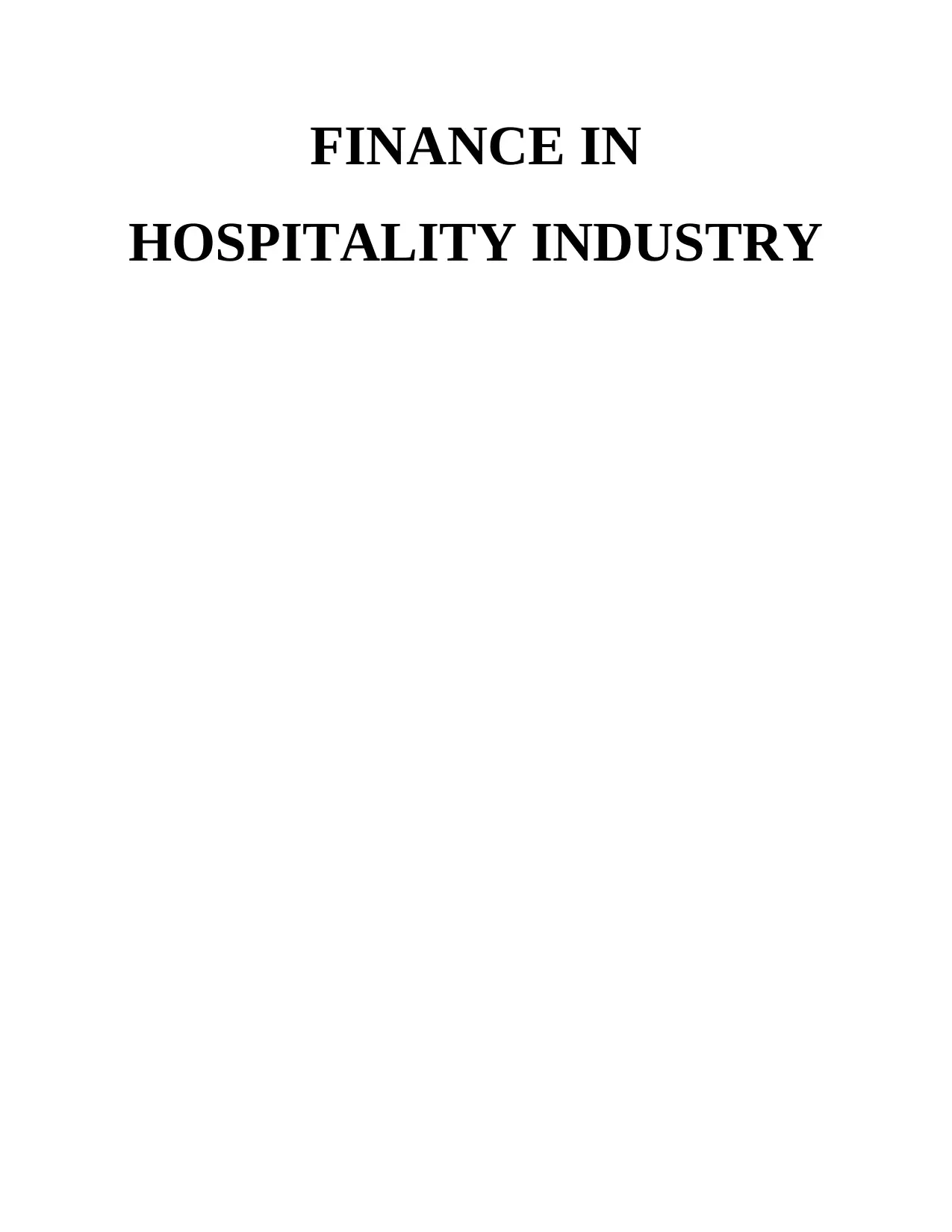
FINANCE IN
HOSPITALITY INDUSTRY
HOSPITALITY INDUSTRY
Paraphrase This Document
Need a fresh take? Get an instant paraphrase of this document with our AI Paraphraser
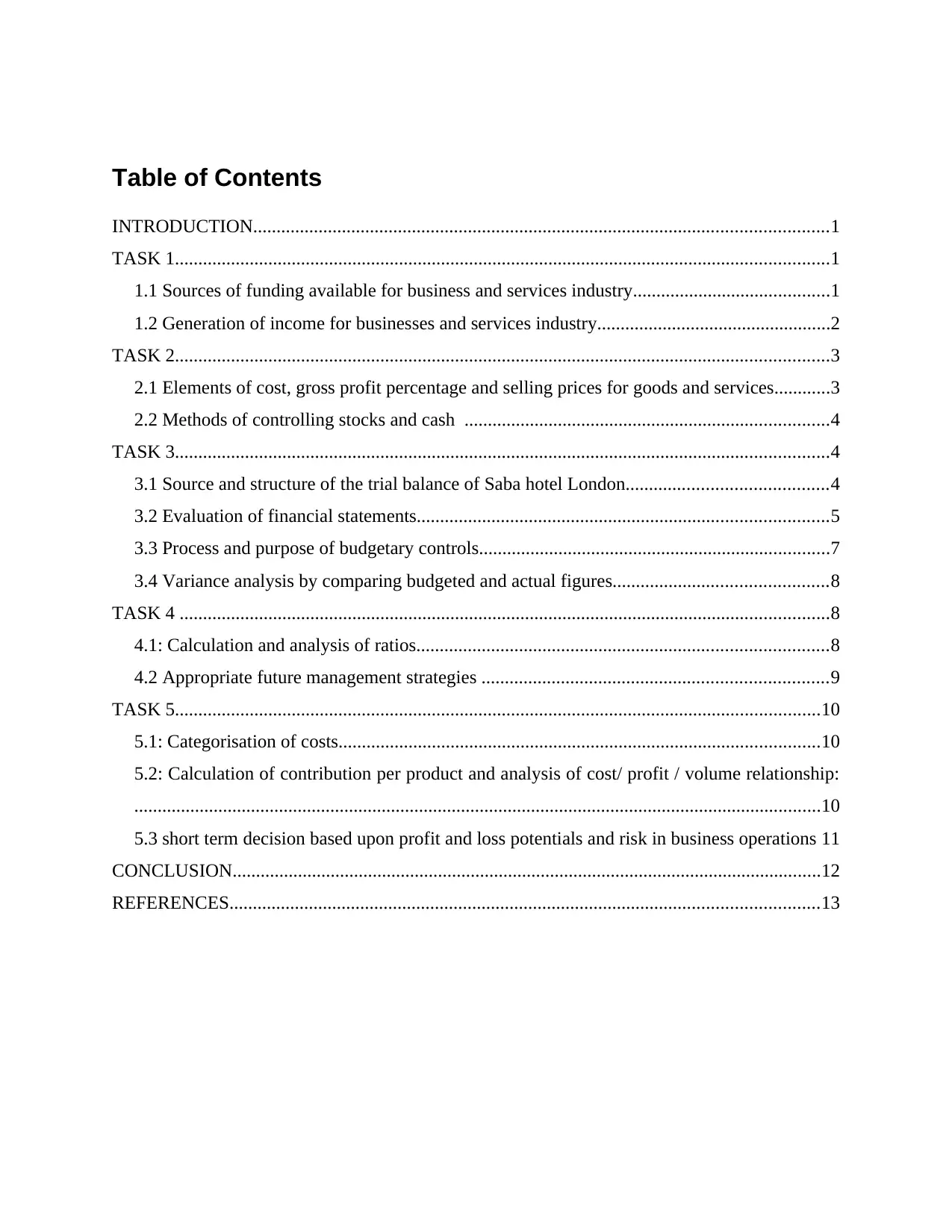
Table of Contents
INTRODUCTION...........................................................................................................................1
TASK 1............................................................................................................................................1
1.1 Sources of funding available for business and services industry..........................................1
1.2 Generation of income for businesses and services industry..................................................2
TASK 2............................................................................................................................................3
2.1 Elements of cost, gross profit percentage and selling prices for goods and services............3
2.2 Methods of controlling stocks and cash ..............................................................................4
TASK 3............................................................................................................................................4
3.1 Source and structure of the trial balance of Saba hotel London...........................................4
3.2 Evaluation of financial statements........................................................................................5
3.3 Process and purpose of budgetary controls...........................................................................7
3.4 Variance analysis by comparing budgeted and actual figures..............................................8
TASK 4 ...........................................................................................................................................8
4.1: Calculation and analysis of ratios........................................................................................8
4.2 Appropriate future management strategies ..........................................................................9
TASK 5..........................................................................................................................................10
5.1: Categorisation of costs.......................................................................................................10
5.2: Calculation of contribution per product and analysis of cost/ profit / volume relationship:
...................................................................................................................................................10
5.3 short term decision based upon profit and loss potentials and risk in business operations 11
CONCLUSION..............................................................................................................................12
REFERENCES..............................................................................................................................13
INTRODUCTION...........................................................................................................................1
TASK 1............................................................................................................................................1
1.1 Sources of funding available for business and services industry..........................................1
1.2 Generation of income for businesses and services industry..................................................2
TASK 2............................................................................................................................................3
2.1 Elements of cost, gross profit percentage and selling prices for goods and services............3
2.2 Methods of controlling stocks and cash ..............................................................................4
TASK 3............................................................................................................................................4
3.1 Source and structure of the trial balance of Saba hotel London...........................................4
3.2 Evaluation of financial statements........................................................................................5
3.3 Process and purpose of budgetary controls...........................................................................7
3.4 Variance analysis by comparing budgeted and actual figures..............................................8
TASK 4 ...........................................................................................................................................8
4.1: Calculation and analysis of ratios........................................................................................8
4.2 Appropriate future management strategies ..........................................................................9
TASK 5..........................................................................................................................................10
5.1: Categorisation of costs.......................................................................................................10
5.2: Calculation of contribution per product and analysis of cost/ profit / volume relationship:
...................................................................................................................................................10
5.3 short term decision based upon profit and loss potentials and risk in business operations 11
CONCLUSION..............................................................................................................................12
REFERENCES..............................................................................................................................13
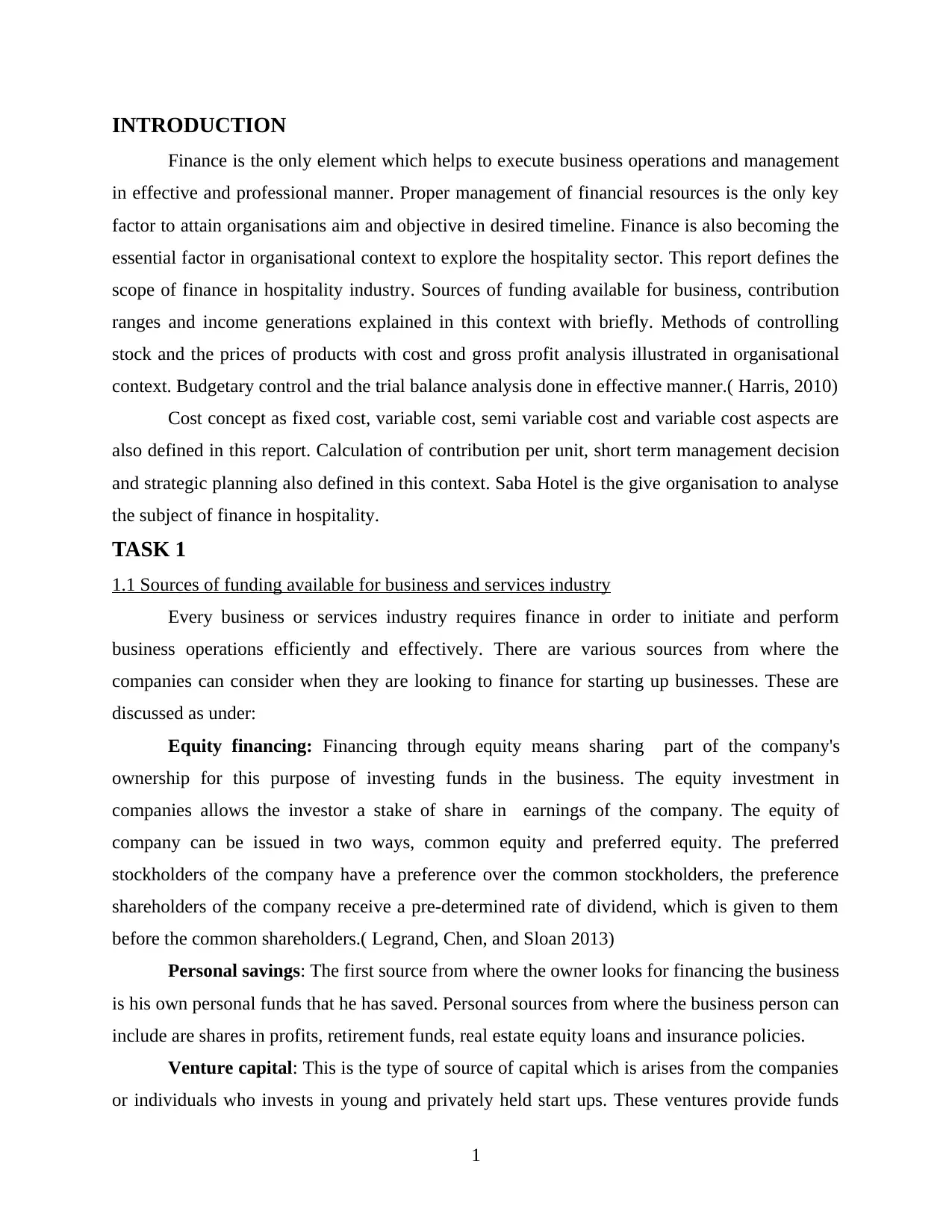
INTRODUCTION
Finance is the only element which helps to execute business operations and management
in effective and professional manner. Proper management of financial resources is the only key
factor to attain organisations aim and objective in desired timeline. Finance is also becoming the
essential factor in organisational context to explore the hospitality sector. This report defines the
scope of finance in hospitality industry. Sources of funding available for business, contribution
ranges and income generations explained in this context with briefly. Methods of controlling
stock and the prices of products with cost and gross profit analysis illustrated in organisational
context. Budgetary control and the trial balance analysis done in effective manner.( Harris, 2010)
Cost concept as fixed cost, variable cost, semi variable cost and variable cost aspects are
also defined in this report. Calculation of contribution per unit, short term management decision
and strategic planning also defined in this context. Saba Hotel is the give organisation to analyse
the subject of finance in hospitality.
TASK 1
1.1 Sources of funding available for business and services industry
Every business or services industry requires finance in order to initiate and perform
business operations efficiently and effectively. There are various sources from where the
companies can consider when they are looking to finance for starting up businesses. These are
discussed as under:
Equity financing: Financing through equity means sharing part of the company's
ownership for this purpose of investing funds in the business. The equity investment in
companies allows the investor a stake of share in earnings of the company. The equity of
company can be issued in two ways, common equity and preferred equity. The preferred
stockholders of the company have a preference over the common stockholders, the preference
shareholders of the company receive a pre-determined rate of dividend, which is given to them
before the common shareholders.( Legrand, Chen, and Sloan 2013)
Personal savings: The first source from where the owner looks for financing the business
is his own personal funds that he has saved. Personal sources from where the business person can
include are shares in profits, retirement funds, real estate equity loans and insurance policies.
Venture capital: This is the type of source of capital which is arises from the companies
or individuals who invests in young and privately held start ups. These ventures provide funds
1
Finance is the only element which helps to execute business operations and management
in effective and professional manner. Proper management of financial resources is the only key
factor to attain organisations aim and objective in desired timeline. Finance is also becoming the
essential factor in organisational context to explore the hospitality sector. This report defines the
scope of finance in hospitality industry. Sources of funding available for business, contribution
ranges and income generations explained in this context with briefly. Methods of controlling
stock and the prices of products with cost and gross profit analysis illustrated in organisational
context. Budgetary control and the trial balance analysis done in effective manner.( Harris, 2010)
Cost concept as fixed cost, variable cost, semi variable cost and variable cost aspects are
also defined in this report. Calculation of contribution per unit, short term management decision
and strategic planning also defined in this context. Saba Hotel is the give organisation to analyse
the subject of finance in hospitality.
TASK 1
1.1 Sources of funding available for business and services industry
Every business or services industry requires finance in order to initiate and perform
business operations efficiently and effectively. There are various sources from where the
companies can consider when they are looking to finance for starting up businesses. These are
discussed as under:
Equity financing: Financing through equity means sharing part of the company's
ownership for this purpose of investing funds in the business. The equity investment in
companies allows the investor a stake of share in earnings of the company. The equity of
company can be issued in two ways, common equity and preferred equity. The preferred
stockholders of the company have a preference over the common stockholders, the preference
shareholders of the company receive a pre-determined rate of dividend, which is given to them
before the common shareholders.( Legrand, Chen, and Sloan 2013)
Personal savings: The first source from where the owner looks for financing the business
is his own personal funds that he has saved. Personal sources from where the business person can
include are shares in profits, retirement funds, real estate equity loans and insurance policies.
Venture capital: This is the type of source of capital which is arises from the companies
or individuals who invests in young and privately held start ups. These ventures provide funds
1
⊘ This is a preview!⊘
Do you want full access?
Subscribe today to unlock all pages.

Trusted by 1+ million students worldwide
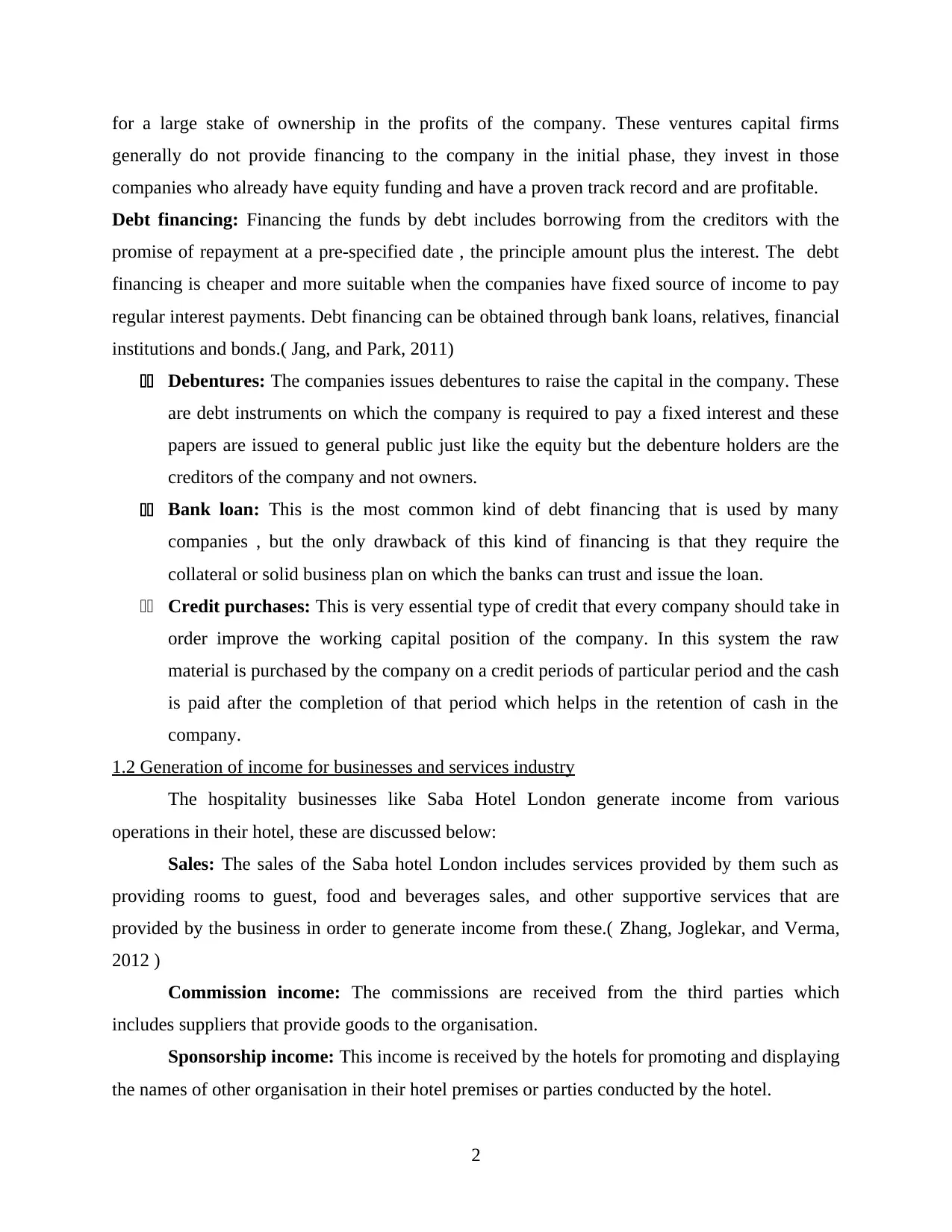
for a large stake of ownership in the profits of the company. These ventures capital firms
generally do not provide financing to the company in the initial phase, they invest in those
companies who already have equity funding and have a proven track record and are profitable.
Debt financing: Financing the funds by debt includes borrowing from the creditors with the
promise of repayment at a pre-specified date , the principle amount plus the interest. The debt
financing is cheaper and more suitable when the companies have fixed source of income to pay
regular interest payments. Debt financing can be obtained through bank loans, relatives, financial
institutions and bonds.( Jang, and Park, 2011)
11 Debentures: The companies issues debentures to raise the capital in the company. These
are debt instruments on which the company is required to pay a fixed interest and these
papers are issued to general public just like the equity but the debenture holders are the
creditors of the company and not owners.
11 Bank loan: This is the most common kind of debt financing that is used by many
companies , but the only drawback of this kind of financing is that they require the
collateral or solid business plan on which the banks can trust and issue the loan.
11 Credit purchases: This is very essential type of credit that every company should take in
order improve the working capital position of the company. In this system the raw
material is purchased by the company on a credit periods of particular period and the cash
is paid after the completion of that period which helps in the retention of cash in the
company.
1.2 Generation of income for businesses and services industry
The hospitality businesses like Saba Hotel London generate income from various
operations in their hotel, these are discussed below:
Sales: The sales of the Saba hotel London includes services provided by them such as
providing rooms to guest, food and beverages sales, and other supportive services that are
provided by the business in order to generate income from these.( Zhang, Joglekar, and Verma,
2012 )
Commission income: The commissions are received from the third parties which
includes suppliers that provide goods to the organisation.
Sponsorship income: This income is received by the hotels for promoting and displaying
the names of other organisation in their hotel premises or parties conducted by the hotel.
2
generally do not provide financing to the company in the initial phase, they invest in those
companies who already have equity funding and have a proven track record and are profitable.
Debt financing: Financing the funds by debt includes borrowing from the creditors with the
promise of repayment at a pre-specified date , the principle amount plus the interest. The debt
financing is cheaper and more suitable when the companies have fixed source of income to pay
regular interest payments. Debt financing can be obtained through bank loans, relatives, financial
institutions and bonds.( Jang, and Park, 2011)
11 Debentures: The companies issues debentures to raise the capital in the company. These
are debt instruments on which the company is required to pay a fixed interest and these
papers are issued to general public just like the equity but the debenture holders are the
creditors of the company and not owners.
11 Bank loan: This is the most common kind of debt financing that is used by many
companies , but the only drawback of this kind of financing is that they require the
collateral or solid business plan on which the banks can trust and issue the loan.
11 Credit purchases: This is very essential type of credit that every company should take in
order improve the working capital position of the company. In this system the raw
material is purchased by the company on a credit periods of particular period and the cash
is paid after the completion of that period which helps in the retention of cash in the
company.
1.2 Generation of income for businesses and services industry
The hospitality businesses like Saba Hotel London generate income from various
operations in their hotel, these are discussed below:
Sales: The sales of the Saba hotel London includes services provided by them such as
providing rooms to guest, food and beverages sales, and other supportive services that are
provided by the business in order to generate income from these.( Zhang, Joglekar, and Verma,
2012 )
Commission income: The commissions are received from the third parties which
includes suppliers that provide goods to the organisation.
Sponsorship income: This income is received by the hotels for promoting and displaying
the names of other organisation in their hotel premises or parties conducted by the hotel.
2
Paraphrase This Document
Need a fresh take? Get an instant paraphrase of this document with our AI Paraphraser
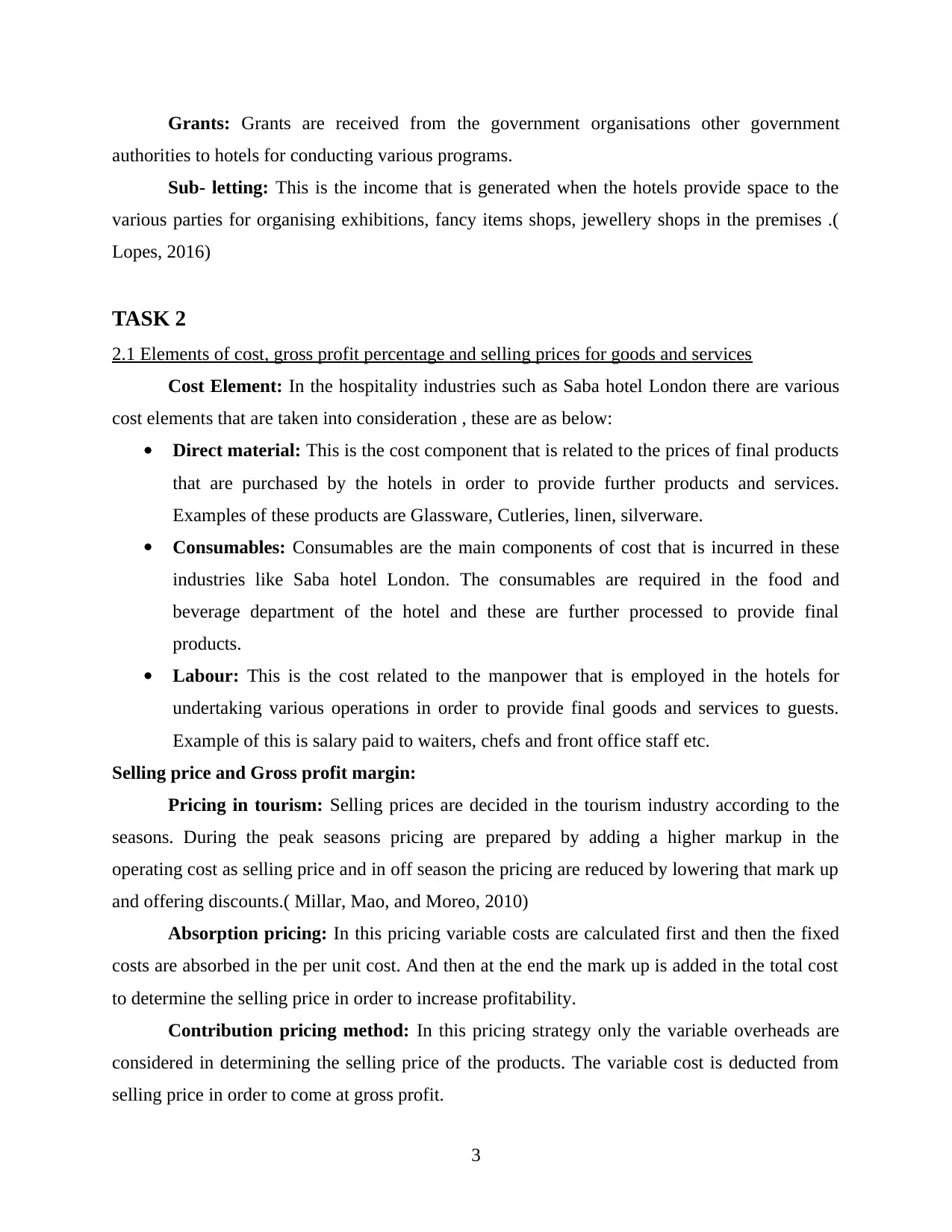
Grants: Grants are received from the government organisations other government
authorities to hotels for conducting various programs.
Sub- letting: This is the income that is generated when the hotels provide space to the
various parties for organising exhibitions, fancy items shops, jewellery shops in the premises .(
Lopes, 2016)
TASK 2
2.1 Elements of cost, gross profit percentage and selling prices for goods and services
Cost Element: In the hospitality industries such as Saba hotel London there are various
cost elements that are taken into consideration , these are as below:
Direct material: This is the cost component that is related to the prices of final products
that are purchased by the hotels in order to provide further products and services.
Examples of these products are Glassware, Cutleries, linen, silverware.
Consumables: Consumables are the main components of cost that is incurred in these
industries like Saba hotel London. The consumables are required in the food and
beverage department of the hotel and these are further processed to provide final
products.
Labour: This is the cost related to the manpower that is employed in the hotels for
undertaking various operations in order to provide final goods and services to guests.
Example of this is salary paid to waiters, chefs and front office staff etc.
Selling price and Gross profit margin:
Pricing in tourism: Selling prices are decided in the tourism industry according to the
seasons. During the peak seasons pricing are prepared by adding a higher markup in the
operating cost as selling price and in off season the pricing are reduced by lowering that mark up
and offering discounts.( Millar, Mao, and Moreo, 2010)
Absorption pricing: In this pricing variable costs are calculated first and then the fixed
costs are absorbed in the per unit cost. And then at the end the mark up is added in the total cost
to determine the selling price in order to increase profitability.
Contribution pricing method: In this pricing strategy only the variable overheads are
considered in determining the selling price of the products. The variable cost is deducted from
selling price in order to come at gross profit.
3
authorities to hotels for conducting various programs.
Sub- letting: This is the income that is generated when the hotels provide space to the
various parties for organising exhibitions, fancy items shops, jewellery shops in the premises .(
Lopes, 2016)
TASK 2
2.1 Elements of cost, gross profit percentage and selling prices for goods and services
Cost Element: In the hospitality industries such as Saba hotel London there are various
cost elements that are taken into consideration , these are as below:
Direct material: This is the cost component that is related to the prices of final products
that are purchased by the hotels in order to provide further products and services.
Examples of these products are Glassware, Cutleries, linen, silverware.
Consumables: Consumables are the main components of cost that is incurred in these
industries like Saba hotel London. The consumables are required in the food and
beverage department of the hotel and these are further processed to provide final
products.
Labour: This is the cost related to the manpower that is employed in the hotels for
undertaking various operations in order to provide final goods and services to guests.
Example of this is salary paid to waiters, chefs and front office staff etc.
Selling price and Gross profit margin:
Pricing in tourism: Selling prices are decided in the tourism industry according to the
seasons. During the peak seasons pricing are prepared by adding a higher markup in the
operating cost as selling price and in off season the pricing are reduced by lowering that mark up
and offering discounts.( Millar, Mao, and Moreo, 2010)
Absorption pricing: In this pricing variable costs are calculated first and then the fixed
costs are absorbed in the per unit cost. And then at the end the mark up is added in the total cost
to determine the selling price in order to increase profitability.
Contribution pricing method: In this pricing strategy only the variable overheads are
considered in determining the selling price of the products. The variable cost is deducted from
selling price in order to come at gross profit.
3
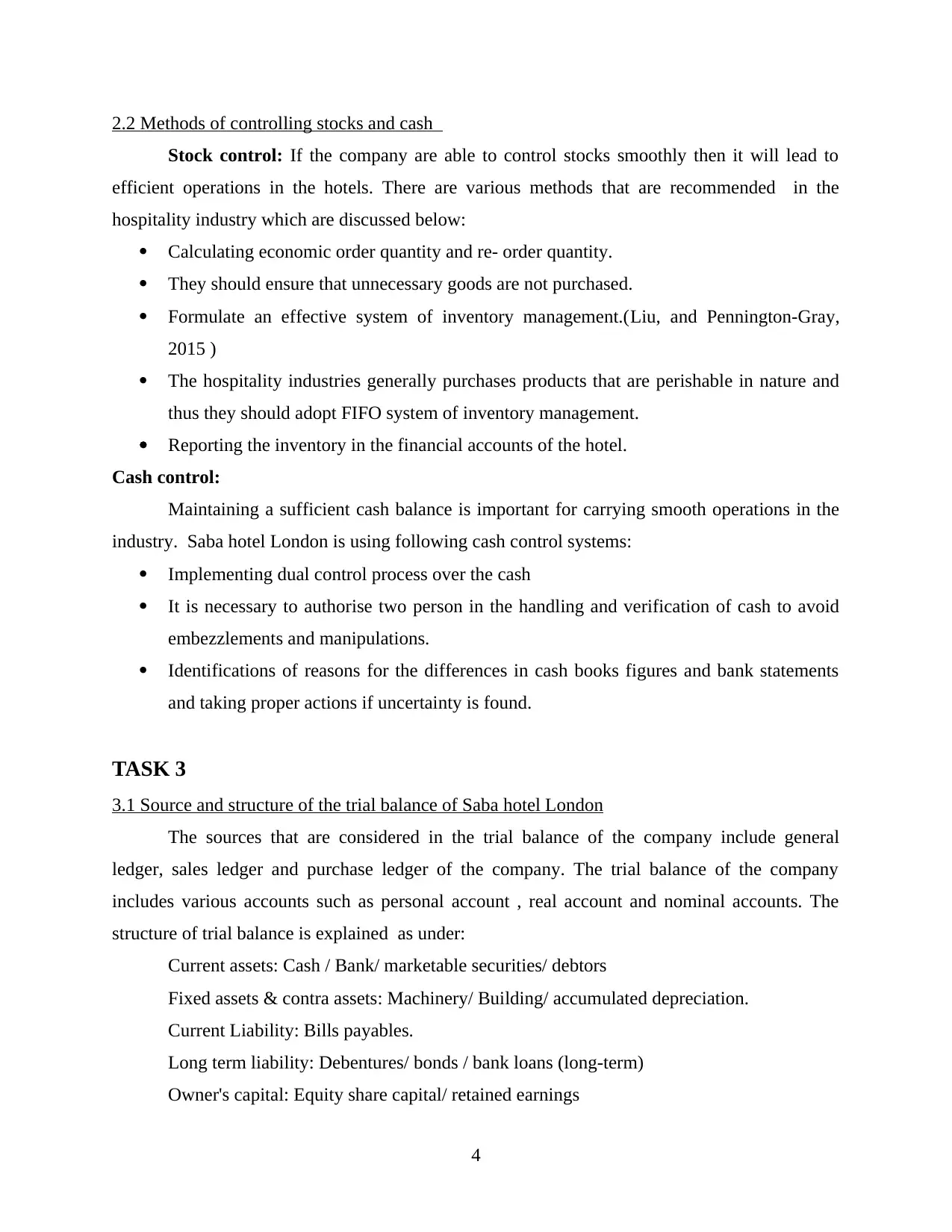
2.2 Methods of controlling stocks and cash
Stock control: If the company are able to control stocks smoothly then it will lead to
efficient operations in the hotels. There are various methods that are recommended in the
hospitality industry which are discussed below:
Calculating economic order quantity and re- order quantity.
They should ensure that unnecessary goods are not purchased.
Formulate an effective system of inventory management.(Liu, and Pennington-Gray,
2015 )
The hospitality industries generally purchases products that are perishable in nature and
thus they should adopt FIFO system of inventory management.
Reporting the inventory in the financial accounts of the hotel.
Cash control:
Maintaining a sufficient cash balance is important for carrying smooth operations in the
industry. Saba hotel London is using following cash control systems:
Implementing dual control process over the cash
It is necessary to authorise two person in the handling and verification of cash to avoid
embezzlements and manipulations.
Identifications of reasons for the differences in cash books figures and bank statements
and taking proper actions if uncertainty is found.
TASK 3
3.1 Source and structure of the trial balance of Saba hotel London
The sources that are considered in the trial balance of the company include general
ledger, sales ledger and purchase ledger of the company. The trial balance of the company
includes various accounts such as personal account , real account and nominal accounts. The
structure of trial balance is explained as under:
Current assets: Cash / Bank/ marketable securities/ debtors
Fixed assets & contra assets: Machinery/ Building/ accumulated depreciation.
Current Liability: Bills payables.
Long term liability: Debentures/ bonds / bank loans (long-term)
Owner's capital: Equity share capital/ retained earnings
4
Stock control: If the company are able to control stocks smoothly then it will lead to
efficient operations in the hotels. There are various methods that are recommended in the
hospitality industry which are discussed below:
Calculating economic order quantity and re- order quantity.
They should ensure that unnecessary goods are not purchased.
Formulate an effective system of inventory management.(Liu, and Pennington-Gray,
2015 )
The hospitality industries generally purchases products that are perishable in nature and
thus they should adopt FIFO system of inventory management.
Reporting the inventory in the financial accounts of the hotel.
Cash control:
Maintaining a sufficient cash balance is important for carrying smooth operations in the
industry. Saba hotel London is using following cash control systems:
Implementing dual control process over the cash
It is necessary to authorise two person in the handling and verification of cash to avoid
embezzlements and manipulations.
Identifications of reasons for the differences in cash books figures and bank statements
and taking proper actions if uncertainty is found.
TASK 3
3.1 Source and structure of the trial balance of Saba hotel London
The sources that are considered in the trial balance of the company include general
ledger, sales ledger and purchase ledger of the company. The trial balance of the company
includes various accounts such as personal account , real account and nominal accounts. The
structure of trial balance is explained as under:
Current assets: Cash / Bank/ marketable securities/ debtors
Fixed assets & contra assets: Machinery/ Building/ accumulated depreciation.
Current Liability: Bills payables.
Long term liability: Debentures/ bonds / bank loans (long-term)
Owner's capital: Equity share capital/ retained earnings
4
⊘ This is a preview!⊘
Do you want full access?
Subscribe today to unlock all pages.

Trusted by 1+ million students worldwide
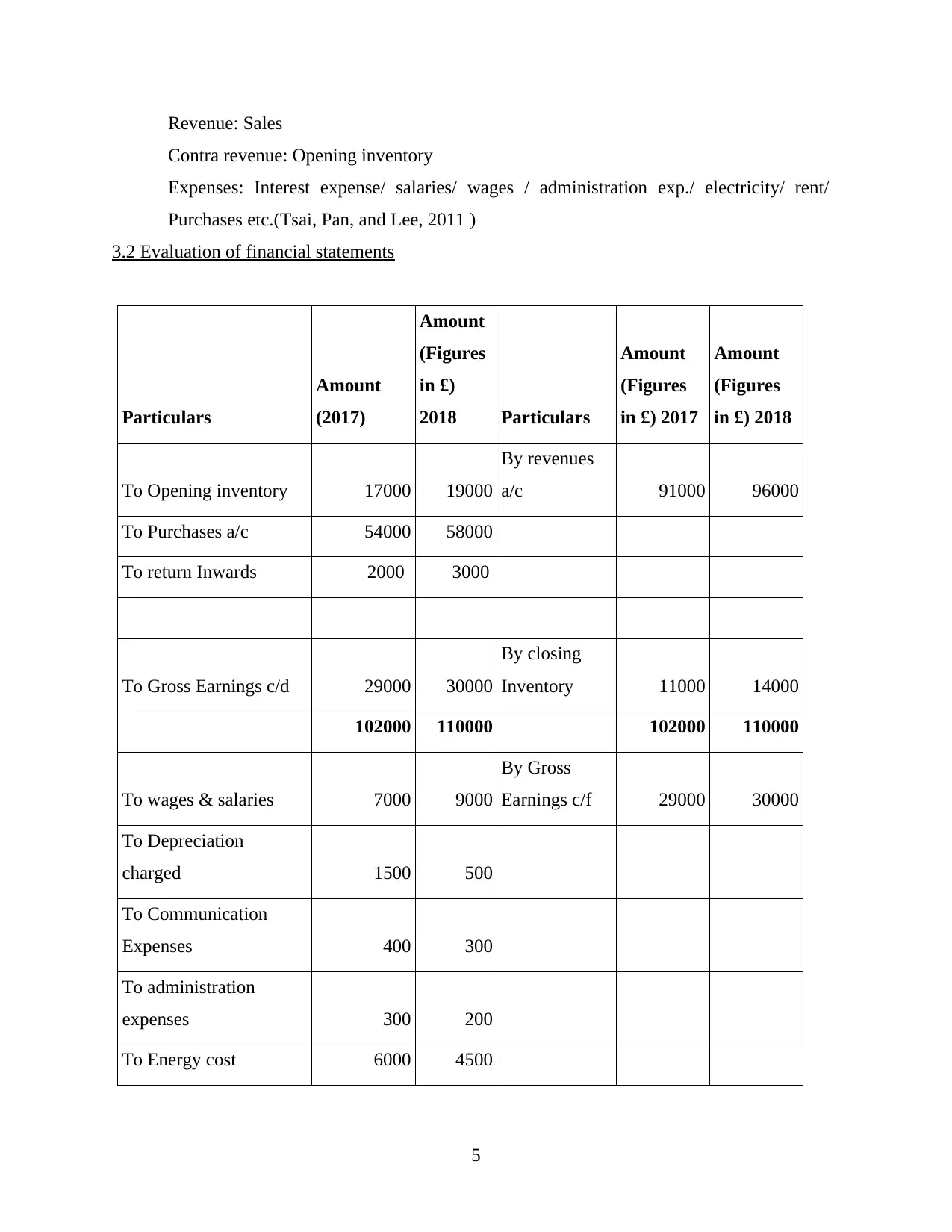
Revenue: Sales
Contra revenue: Opening inventory
Expenses: Interest expense/ salaries/ wages / administration exp./ electricity/ rent/
Purchases etc.(Tsai, Pan, and Lee, 2011 )
3.2 Evaluation of financial statements
Particulars
Amount
(2017)
Amount
(Figures
in £)
2018 Particulars
Amount
(Figures
in £) 2017
Amount
(Figures
in £) 2018
To Opening inventory 17000 19000
By revenues
a/c 91000 96000
To Purchases a/c 54000 58000
To return Inwards 2000 3000
To Gross Earnings c/d 29000 30000
By closing
Inventory 11000 14000
102000 110000 102000 110000
To wages & salaries 7000 9000
By Gross
Earnings c/f 29000 30000
To Depreciation
charged 1500 500
To Communication
Expenses 400 300
To administration
expenses 300 200
To Energy cost 6000 4500
5
Contra revenue: Opening inventory
Expenses: Interest expense/ salaries/ wages / administration exp./ electricity/ rent/
Purchases etc.(Tsai, Pan, and Lee, 2011 )
3.2 Evaluation of financial statements
Particulars
Amount
(2017)
Amount
(Figures
in £)
2018 Particulars
Amount
(Figures
in £) 2017
Amount
(Figures
in £) 2018
To Opening inventory 17000 19000
By revenues
a/c 91000 96000
To Purchases a/c 54000 58000
To return Inwards 2000 3000
To Gross Earnings c/d 29000 30000
By closing
Inventory 11000 14000
102000 110000 102000 110000
To wages & salaries 7000 9000
By Gross
Earnings c/f 29000 30000
To Depreciation
charged 1500 500
To Communication
Expenses 400 300
To administration
expenses 300 200
To Energy cost 6000 4500
5
Paraphrase This Document
Need a fresh take? Get an instant paraphrase of this document with our AI Paraphraser
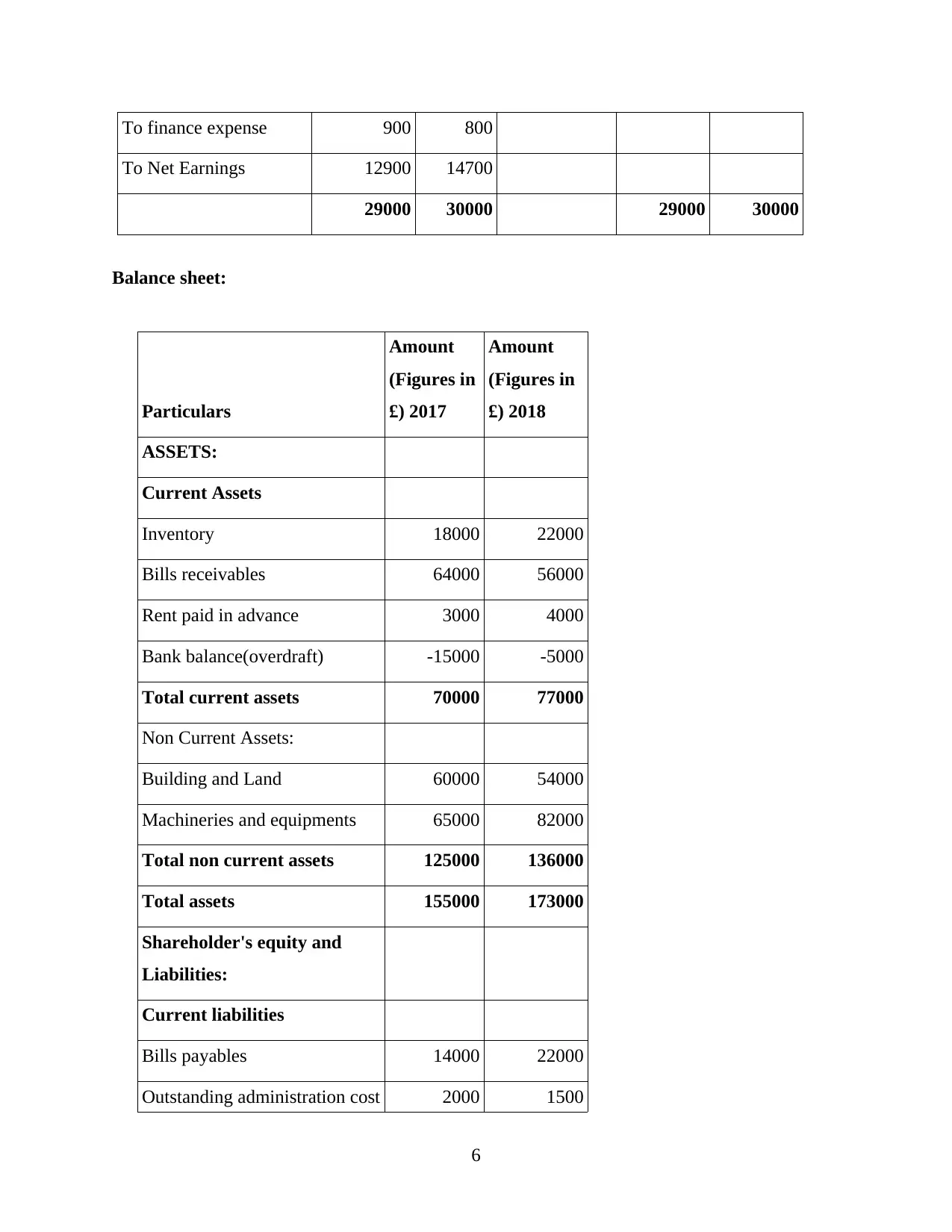
To finance expense 900 800
To Net Earnings 12900 14700
29000 30000 29000 30000
Balance sheet:
Particulars
Amount
(Figures in
£) 2017
Amount
(Figures in
£) 2018
ASSETS:
Current Assets
Inventory 18000 22000
Bills receivables 64000 56000
Rent paid in advance 3000 4000
Bank balance(overdraft) -15000 -5000
Total current assets 70000 77000
Non Current Assets:
Building and Land 60000 54000
Machineries and equipments 65000 82000
Total non current assets 125000 136000
Total assets 155000 173000
Shareholder's equity and
Liabilities:
Current liabilities
Bills payables 14000 22000
Outstanding administration cost 2000 1500
6
To Net Earnings 12900 14700
29000 30000 29000 30000
Balance sheet:
Particulars
Amount
(Figures in
£) 2017
Amount
(Figures in
£) 2018
ASSETS:
Current Assets
Inventory 18000 22000
Bills receivables 64000 56000
Rent paid in advance 3000 4000
Bank balance(overdraft) -15000 -5000
Total current assets 70000 77000
Non Current Assets:
Building and Land 60000 54000
Machineries and equipments 65000 82000
Total non current assets 125000 136000
Total assets 155000 173000
Shareholder's equity and
Liabilities:
Current liabilities
Bills payables 14000 22000
Outstanding administration cost 2000 1500
6
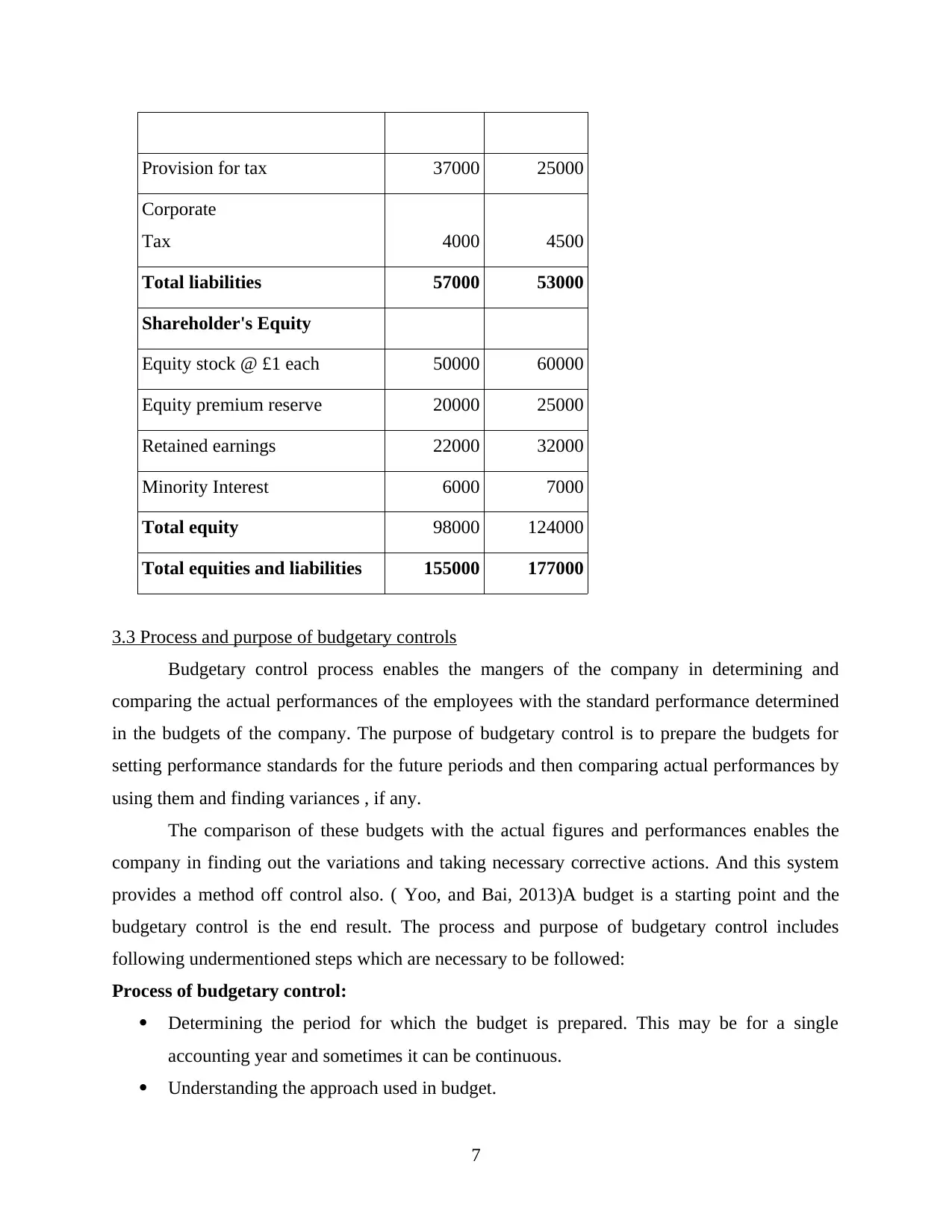
Provision for tax 37000 25000
Corporate
Tax 4000 4500
Total liabilities 57000 53000
Shareholder's Equity
Equity stock @ £1 each 50000 60000
Equity premium reserve 20000 25000
Retained earnings 22000 32000
Minority Interest 6000 7000
Total equity 98000 124000
Total equities and liabilities 155000 177000
3.3 Process and purpose of budgetary controls
Budgetary control process enables the mangers of the company in determining and
comparing the actual performances of the employees with the standard performance determined
in the budgets of the company. The purpose of budgetary control is to prepare the budgets for
setting performance standards for the future periods and then comparing actual performances by
using them and finding variances , if any.
The comparison of these budgets with the actual figures and performances enables the
company in finding out the variations and taking necessary corrective actions. And this system
provides a method off control also. ( Yoo, and Bai, 2013)A budget is a starting point and the
budgetary control is the end result. The process and purpose of budgetary control includes
following undermentioned steps which are necessary to be followed:
Process of budgetary control:
Determining the period for which the budget is prepared. This may be for a single
accounting year and sometimes it can be continuous.
Understanding the approach used in budget.
7
Corporate
Tax 4000 4500
Total liabilities 57000 53000
Shareholder's Equity
Equity stock @ £1 each 50000 60000
Equity premium reserve 20000 25000
Retained earnings 22000 32000
Minority Interest 6000 7000
Total equity 98000 124000
Total equities and liabilities 155000 177000
3.3 Process and purpose of budgetary controls
Budgetary control process enables the mangers of the company in determining and
comparing the actual performances of the employees with the standard performance determined
in the budgets of the company. The purpose of budgetary control is to prepare the budgets for
setting performance standards for the future periods and then comparing actual performances by
using them and finding variances , if any.
The comparison of these budgets with the actual figures and performances enables the
company in finding out the variations and taking necessary corrective actions. And this system
provides a method off control also. ( Yoo, and Bai, 2013)A budget is a starting point and the
budgetary control is the end result. The process and purpose of budgetary control includes
following undermentioned steps which are necessary to be followed:
Process of budgetary control:
Determining the period for which the budget is prepared. This may be for a single
accounting year and sometimes it can be continuous.
Understanding the approach used in budget.
7
⊘ This is a preview!⊘
Do you want full access?
Subscribe today to unlock all pages.

Trusted by 1+ million students worldwide
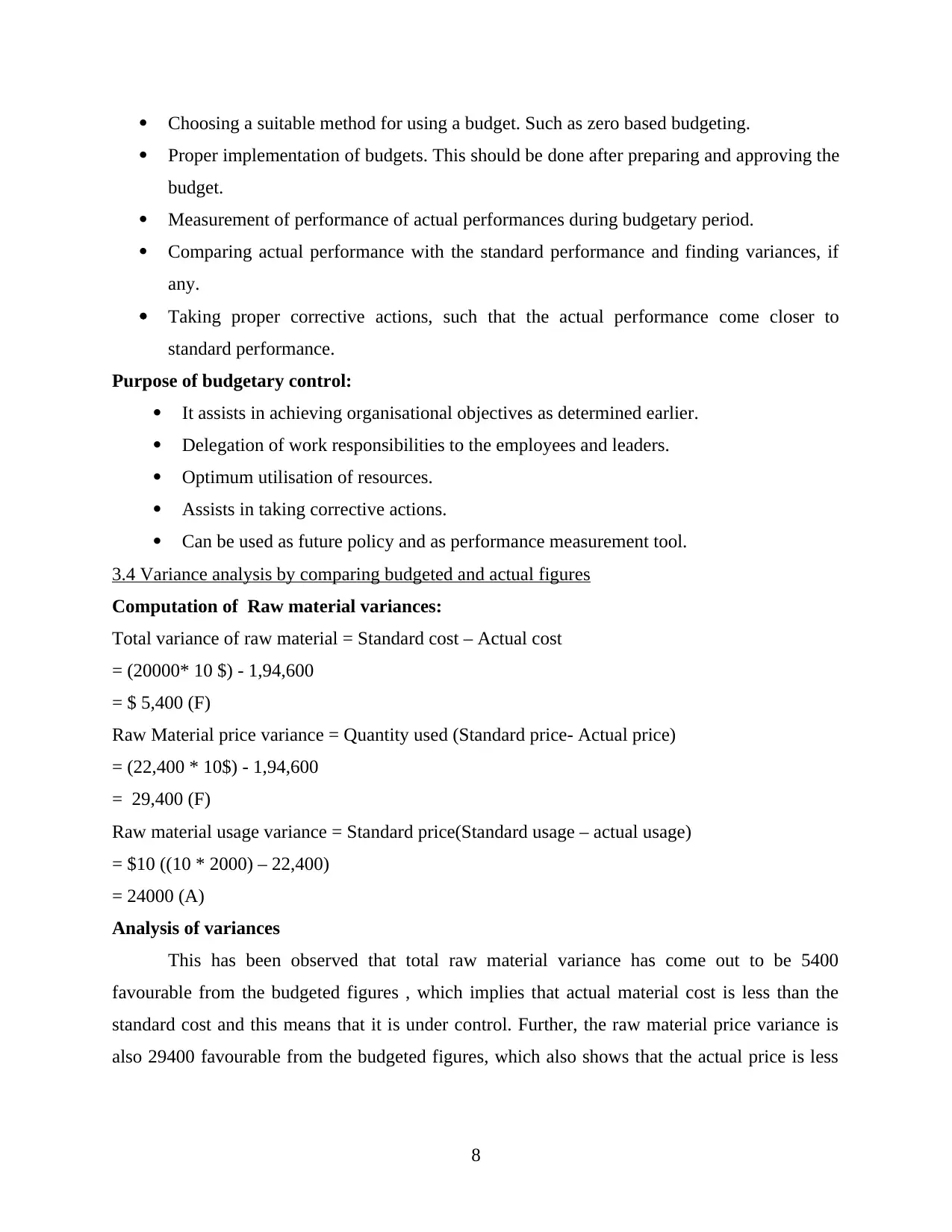
Choosing a suitable method for using a budget. Such as zero based budgeting.
Proper implementation of budgets. This should be done after preparing and approving the
budget.
Measurement of performance of actual performances during budgetary period.
Comparing actual performance with the standard performance and finding variances, if
any.
Taking proper corrective actions, such that the actual performance come closer to
standard performance.
Purpose of budgetary control:
It assists in achieving organisational objectives as determined earlier.
Delegation of work responsibilities to the employees and leaders.
Optimum utilisation of resources.
Assists in taking corrective actions.
Can be used as future policy and as performance measurement tool.
3.4 Variance analysis by comparing budgeted and actual figures
Computation of Raw material variances:
Total variance of raw material = Standard cost – Actual cost
= (20000* 10 $) - 1,94,600
= $ 5,400 (F)
Raw Material price variance = Quantity used (Standard price- Actual price)
= (22,400 * 10$) - 1,94,600
= 29,400 (F)
Raw material usage variance = Standard price(Standard usage – actual usage)
= $10 ((10 * 2000) – 22,400)
= 24000 (A)
Analysis of variances
This has been observed that total raw material variance has come out to be 5400
favourable from the budgeted figures , which implies that actual material cost is less than the
standard cost and this means that it is under control. Further, the raw material price variance is
also 29400 favourable from the budgeted figures, which also shows that the actual price is less
8
Proper implementation of budgets. This should be done after preparing and approving the
budget.
Measurement of performance of actual performances during budgetary period.
Comparing actual performance with the standard performance and finding variances, if
any.
Taking proper corrective actions, such that the actual performance come closer to
standard performance.
Purpose of budgetary control:
It assists in achieving organisational objectives as determined earlier.
Delegation of work responsibilities to the employees and leaders.
Optimum utilisation of resources.
Assists in taking corrective actions.
Can be used as future policy and as performance measurement tool.
3.4 Variance analysis by comparing budgeted and actual figures
Computation of Raw material variances:
Total variance of raw material = Standard cost – Actual cost
= (20000* 10 $) - 1,94,600
= $ 5,400 (F)
Raw Material price variance = Quantity used (Standard price- Actual price)
= (22,400 * 10$) - 1,94,600
= 29,400 (F)
Raw material usage variance = Standard price(Standard usage – actual usage)
= $10 ((10 * 2000) – 22,400)
= 24000 (A)
Analysis of variances
This has been observed that total raw material variance has come out to be 5400
favourable from the budgeted figures , which implies that actual material cost is less than the
standard cost and this means that it is under control. Further, the raw material price variance is
also 29400 favourable from the budgeted figures, which also shows that the actual price is less
8
Paraphrase This Document
Need a fresh take? Get an instant paraphrase of this document with our AI Paraphraser
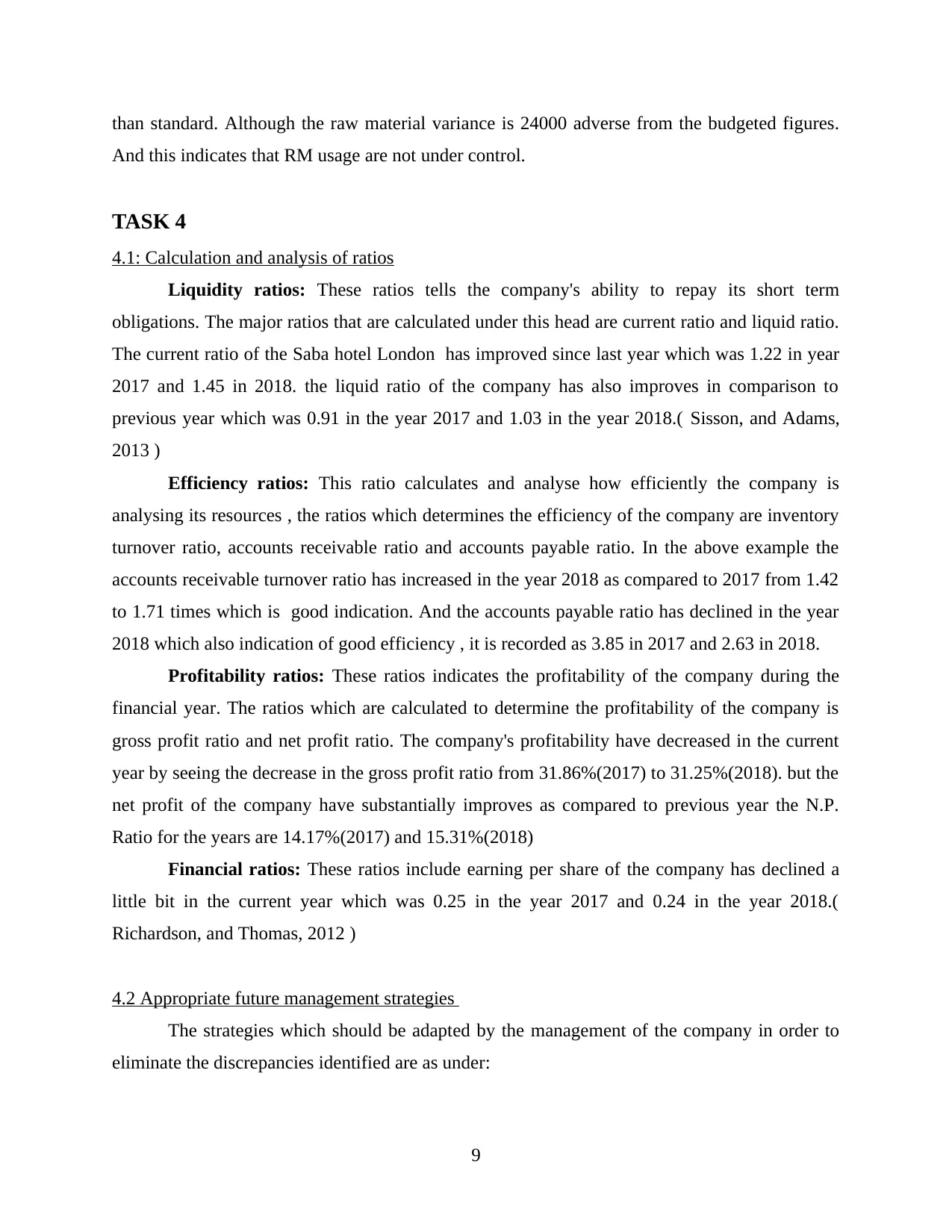
than standard. Although the raw material variance is 24000 adverse from the budgeted figures.
And this indicates that RM usage are not under control.
TASK 4
4.1: Calculation and analysis of ratios
Liquidity ratios: These ratios tells the company's ability to repay its short term
obligations. The major ratios that are calculated under this head are current ratio and liquid ratio.
The current ratio of the Saba hotel London has improved since last year which was 1.22 in year
2017 and 1.45 in 2018. the liquid ratio of the company has also improves in comparison to
previous year which was 0.91 in the year 2017 and 1.03 in the year 2018.( Sisson, and Adams,
2013 )
Efficiency ratios: This ratio calculates and analyse how efficiently the company is
analysing its resources , the ratios which determines the efficiency of the company are inventory
turnover ratio, accounts receivable ratio and accounts payable ratio. In the above example the
accounts receivable turnover ratio has increased in the year 2018 as compared to 2017 from 1.42
to 1.71 times which is good indication. And the accounts payable ratio has declined in the year
2018 which also indication of good efficiency , it is recorded as 3.85 in 2017 and 2.63 in 2018.
Profitability ratios: These ratios indicates the profitability of the company during the
financial year. The ratios which are calculated to determine the profitability of the company is
gross profit ratio and net profit ratio. The company's profitability have decreased in the current
year by seeing the decrease in the gross profit ratio from 31.86%(2017) to 31.25%(2018). but the
net profit of the company have substantially improves as compared to previous year the N.P.
Ratio for the years are 14.17%(2017) and 15.31%(2018)
Financial ratios: These ratios include earning per share of the company has declined a
little bit in the current year which was 0.25 in the year 2017 and 0.24 in the year 2018.(
Richardson, and Thomas, 2012 )
4.2 Appropriate future management strategies
The strategies which should be adapted by the management of the company in order to
eliminate the discrepancies identified are as under:
9
And this indicates that RM usage are not under control.
TASK 4
4.1: Calculation and analysis of ratios
Liquidity ratios: These ratios tells the company's ability to repay its short term
obligations. The major ratios that are calculated under this head are current ratio and liquid ratio.
The current ratio of the Saba hotel London has improved since last year which was 1.22 in year
2017 and 1.45 in 2018. the liquid ratio of the company has also improves in comparison to
previous year which was 0.91 in the year 2017 and 1.03 in the year 2018.( Sisson, and Adams,
2013 )
Efficiency ratios: This ratio calculates and analyse how efficiently the company is
analysing its resources , the ratios which determines the efficiency of the company are inventory
turnover ratio, accounts receivable ratio and accounts payable ratio. In the above example the
accounts receivable turnover ratio has increased in the year 2018 as compared to 2017 from 1.42
to 1.71 times which is good indication. And the accounts payable ratio has declined in the year
2018 which also indication of good efficiency , it is recorded as 3.85 in 2017 and 2.63 in 2018.
Profitability ratios: These ratios indicates the profitability of the company during the
financial year. The ratios which are calculated to determine the profitability of the company is
gross profit ratio and net profit ratio. The company's profitability have decreased in the current
year by seeing the decrease in the gross profit ratio from 31.86%(2017) to 31.25%(2018). but the
net profit of the company have substantially improves as compared to previous year the N.P.
Ratio for the years are 14.17%(2017) and 15.31%(2018)
Financial ratios: These ratios include earning per share of the company has declined a
little bit in the current year which was 0.25 in the year 2017 and 0.24 in the year 2018.(
Richardson, and Thomas, 2012 )
4.2 Appropriate future management strategies
The strategies which should be adapted by the management of the company in order to
eliminate the discrepancies identified are as under:
9
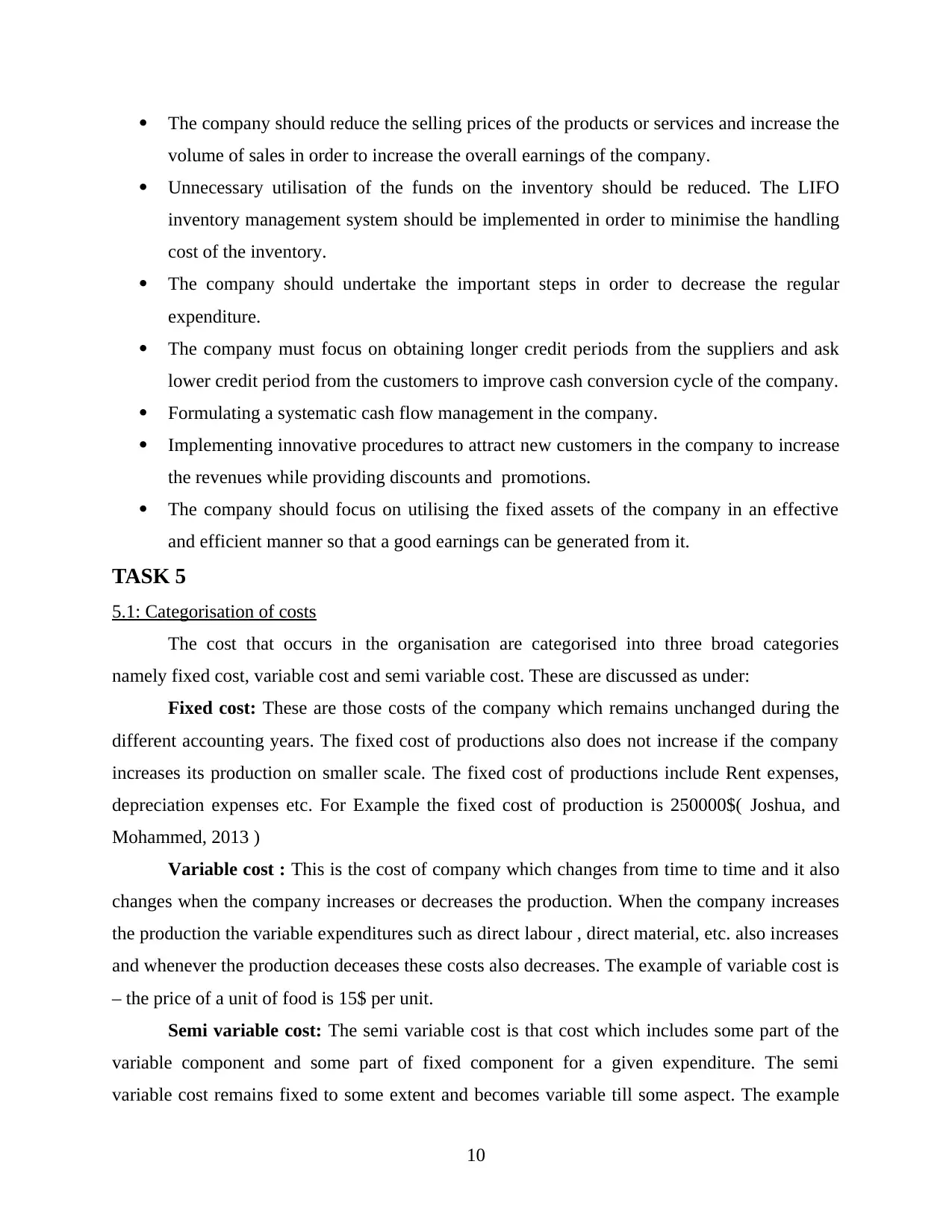
The company should reduce the selling prices of the products or services and increase the
volume of sales in order to increase the overall earnings of the company.
Unnecessary utilisation of the funds on the inventory should be reduced. The LIFO
inventory management system should be implemented in order to minimise the handling
cost of the inventory.
The company should undertake the important steps in order to decrease the regular
expenditure.
The company must focus on obtaining longer credit periods from the suppliers and ask
lower credit period from the customers to improve cash conversion cycle of the company.
Formulating a systematic cash flow management in the company.
Implementing innovative procedures to attract new customers in the company to increase
the revenues while providing discounts and promotions.
The company should focus on utilising the fixed assets of the company in an effective
and efficient manner so that a good earnings can be generated from it.
TASK 5
5.1: Categorisation of costs
The cost that occurs in the organisation are categorised into three broad categories
namely fixed cost, variable cost and semi variable cost. These are discussed as under:
Fixed cost: These are those costs of the company which remains unchanged during the
different accounting years. The fixed cost of productions also does not increase if the company
increases its production on smaller scale. The fixed cost of productions include Rent expenses,
depreciation expenses etc. For Example the fixed cost of production is 250000$( Joshua, and
Mohammed, 2013 )
Variable cost : This is the cost of company which changes from time to time and it also
changes when the company increases or decreases the production. When the company increases
the production the variable expenditures such as direct labour , direct material, etc. also increases
and whenever the production deceases these costs also decreases. The example of variable cost is
– the price of a unit of food is 15$ per unit.
Semi variable cost: The semi variable cost is that cost which includes some part of the
variable component and some part of fixed component for a given expenditure. The semi
variable cost remains fixed to some extent and becomes variable till some aspect. The example
10
volume of sales in order to increase the overall earnings of the company.
Unnecessary utilisation of the funds on the inventory should be reduced. The LIFO
inventory management system should be implemented in order to minimise the handling
cost of the inventory.
The company should undertake the important steps in order to decrease the regular
expenditure.
The company must focus on obtaining longer credit periods from the suppliers and ask
lower credit period from the customers to improve cash conversion cycle of the company.
Formulating a systematic cash flow management in the company.
Implementing innovative procedures to attract new customers in the company to increase
the revenues while providing discounts and promotions.
The company should focus on utilising the fixed assets of the company in an effective
and efficient manner so that a good earnings can be generated from it.
TASK 5
5.1: Categorisation of costs
The cost that occurs in the organisation are categorised into three broad categories
namely fixed cost, variable cost and semi variable cost. These are discussed as under:
Fixed cost: These are those costs of the company which remains unchanged during the
different accounting years. The fixed cost of productions also does not increase if the company
increases its production on smaller scale. The fixed cost of productions include Rent expenses,
depreciation expenses etc. For Example the fixed cost of production is 250000$( Joshua, and
Mohammed, 2013 )
Variable cost : This is the cost of company which changes from time to time and it also
changes when the company increases or decreases the production. When the company increases
the production the variable expenditures such as direct labour , direct material, etc. also increases
and whenever the production deceases these costs also decreases. The example of variable cost is
– the price of a unit of food is 15$ per unit.
Semi variable cost: The semi variable cost is that cost which includes some part of the
variable component and some part of fixed component for a given expenditure. The semi
variable cost remains fixed to some extent and becomes variable till some aspect. The example
10
⊘ This is a preview!⊘
Do you want full access?
Subscribe today to unlock all pages.

Trusted by 1+ million students worldwide
1 out of 16
Related Documents
Your All-in-One AI-Powered Toolkit for Academic Success.
+13062052269
info@desklib.com
Available 24*7 on WhatsApp / Email
![[object Object]](/_next/static/media/star-bottom.7253800d.svg)
Unlock your academic potential
Copyright © 2020–2025 A2Z Services. All Rights Reserved. Developed and managed by ZUCOL.





